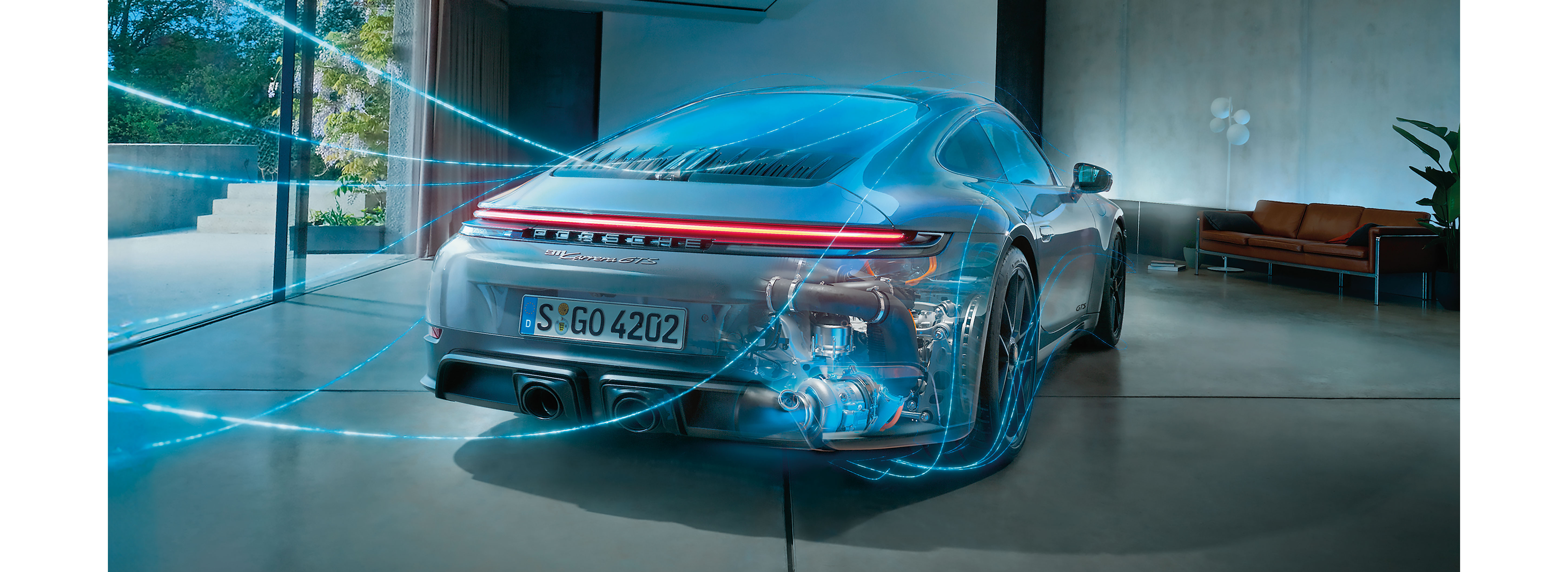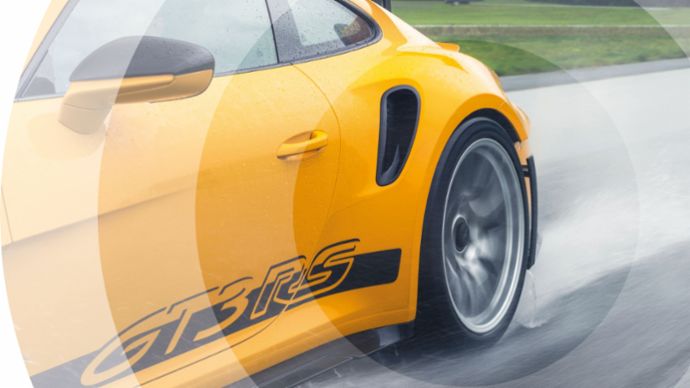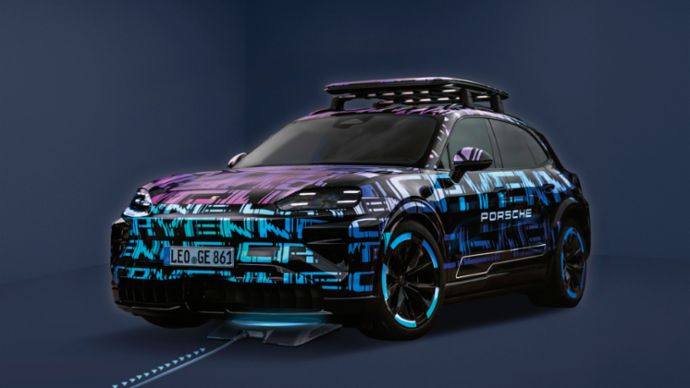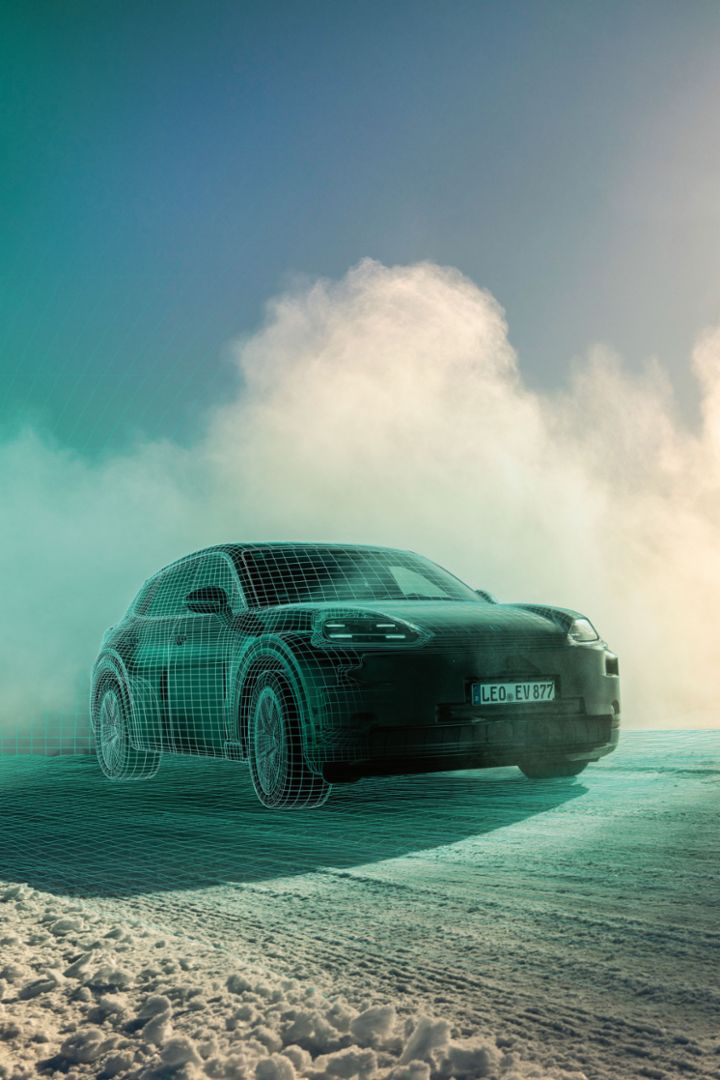Staying Power
The story of the Porsche 911 drive technology is a story of continuous innovation and unique heritage. The highlight for now: high-performance partial hybridization for the 992 generation.
The interim result after six decades of 911 drive development: twice the displacement, four times the power, and an unchanged basic concept. “We’re surprised again and again at how improvable and adaptable the six-cylinder boxer engine is,” says Thomas Krickelberg, Head of Operating Excellence in the 911/718 series. Going forward, there will be an electric exhaust gas turbocharger for even greater power and thrust coupled with lower emissions. So, as it enters its seventh decade, what is the fantastic basis which has been reinvented time and again?

The original:
The compact design, high performance, and low weight of the first six-cylinder boxer engine from Porsche laid the foundations for all future further developments.The Mezger engine
When Porsche unveiled the future 911 in 1963, still known as the 901, its six-cylinder boxer engine delivered power of 96 kW (130 PS) with displacement of two liters. “Compact design, low weight, maximum performance,” says Albrecht Reustle, boxer engine construction specialist at Porsche, summing up the qualities that apply to this day. Until 1993, he worked under Hans Mezger – the design engineer under whose name the engine became famous.
911 with turbocharger
Every generation of the 911 sets milestones in drive technology. The turbo technology tested in motorsport was ready for 911 production in 1974. Thanks to the combination of exhaust gas turbocharging and fuel injection, the 930 type was streets ahead of the competition in terms of performance and efficiency with its 191 kW (260 PS) in Europe.
It met strict exhaust gas regulations from the start. “Looking back, you realize that turbocharging revolutionized the entire world of combustion engines,” says Krickelberg. Turbo engines are an engineer’s dream as they use the energy from hot exhaust gases that would otherwise go to waste. Their centerpiece is the turbocharger, consisting of a turbine wheel and compressor wheel that are firmly attached to one another. The turbine is powered by the engine exhaust gases and achieves speeds of close to 200,000 rpm. The compressor wheel rotates at the same speed and feeds the cylinders with compressed air. The additional fresh air promotes combustion, thus boosting the engine’s performance. To avoid subjecting the engine parts to excessive strain, the pressure generated in the turbocharger by the exhaust gas flow has to be limited. When the boost pressure hits a certain limit, the exhaust gases escape via a bypass valve called the waste gate.

High pressure:
The first turbocharger catapulted the series production 911 into a new dimension of performance.Performance boost thanks to intercooling
The Porsche engineers refined the turbo principle on the basis of ongoing development work. The air gets hot due to being compressed and because of the high temperatures on the turbine side. This has a negative impact on the filling of the cylinders and on the combustion of the injected fuel. From the 1978 model year, the compressed intake air was cooled on its way to the combustion chamber, as had already been put to the test in motorsport. The cooler is mounted on the imposing rear spoiler under a grille. This elaborate intercooling boosts performance to 221 kW (300 PS) in specific markets and enables remarkable engine elasticity.
Another inherent problem with the turbo engine was initially tricky to get a handle on: delayed response when accelerating. At low speeds, the 911 Turbo responds to acceleration much like its weaker counterpart with a naturally aspirated engine. But immense thrust then kicks in from approximately 3,500 rpm. “We needed to close this ‘turbo lag’ to achieve better drivability,” explains developer Krickelberg.
Biturbo: a stormy development
Porsche presented a solution with the fourth-generation 911 Turbo (993). The most powerful production Porsche at the time boasting 300 kW (408 PS) was rolled out in spring 1995. Featuring two turbochargers and two intercoolers for the first time, its 3.6-liter power unit made quite an impression. Two smaller turbines accelerate more quickly than one big one. In particular the smaller rotors’ lower moment of inertia has a positive effect. “And to reliably put the power on the road,” adds Krickelberg, “the 993 Turbo came with enhanced all-wheel drive as standard.” Thanks to the progress made in engine control and sensors as well as modern exhaust aftertreatment, the Turbo model in the last air-cooled 911 generation was considered the lowest-emission production automobile of its day.
Moving into the 21st century with water-cooling
August Achleitner called the switch from air- to water-cooling in the six-cylinder boxer engine of the fifth-generation 911 (996) in the late 1990s a “ticket to the new technology.” Achleitner was Head of Technical Product Planning at the time and was responsible for the 911 series from 2001 to 2018. Water-cooling was a prerequisite for further performance enhancements, more efficient consumption, and compliance with exhaust gas and noise laws. The Porsche design engineers developed cylinder heads with four valves per combustion chamber. “As early as in 1970, preliminary V12 engine testing with an air-cooled four-valve was performed on a 908 type, planned for subsequent use in the 917. The idea was then picked up again in the 1980s in 911 series production development and was put through its paces on the test bench with the 964 generation,” recalls Albrecht Reustle. “But the cylinder head literally melted.” Once again, the solution came from motorsport: the successful endurance prototype 962 was already operating with water-cooled cylinder heads, as was the 959 supercar. In spite of all the debate back then surrounding the retirement of air-cooling, the 996 generation proved to be a game-changing success.
“Turbocharging revolutionized the world of combustion engines.”
Thomas Krickelberg
Variable turbine geometry
In 2006, the 911 Turbo (997) made a splash with a noticeable performance increase: power and torque increased by more than 10 percent. Above all thanks to a new and globally unique technology – variable turbine geometry (VTG). This allows for turbocharger efficiency optimization over a wider speed range by adapting the angle and therefore also the cross-section of the exhaust gas flowing past the turbine blades. “The development of VTG was pioneering and VTG has been a USP in gas engine turbo technology for close to 20 years,” explains Thomas Krickelberg. “To vary the flow of exhaust gas to the turbine, you need to be able to specifically modify the little blades at temperatures in excess of 1,832 degrees Fahrenheit.” It used materials that were also used in the Space Shuttle.
Less displacement, more power and efficiency
The next milestone after the introduction of water-cooling and VTG followed in 2015: turbocharging of the basic models Carrera and Carrera S of the 991 generation. Krickelberg: “We reduced the displacement and were able to simultaneously achieve a considerable increase in performance.” Altogether 20 PS more power was initially realized with the new engine generation featuring biturbo chargers – coupled with lower consumption.
Sporty hybridization
The design engineers are again exploring new avenues to perfect the six-cylinder boxer engine with the overhaul of the current 911 generation (992) in summer 2024 (911 Carrera GTS: Fuel consumption* combined (WLTP) 10.7 – 10.2 l/100 km, CO₂ emissions* combined (WLTP) 242 – 230 g/km, CO₂ class G ). The new 911 Carrera GTS is the first road-legal 911 to feature a particularly lightweight high-performance hybrid powertrain. The newly developed, innovative engine not only allows for another significant increase in power and improved acceleration – it is also readying the vehicle for future emission standards. “We developed and tested all kinds of ideas and approaches in order to choose a hybrid system that’s the perfect fit for the 911. The result is a unique engine that fits with the overall 911 concept and significantly boosts its performance,” says Frank Moser, head of the 911 and 718 series.
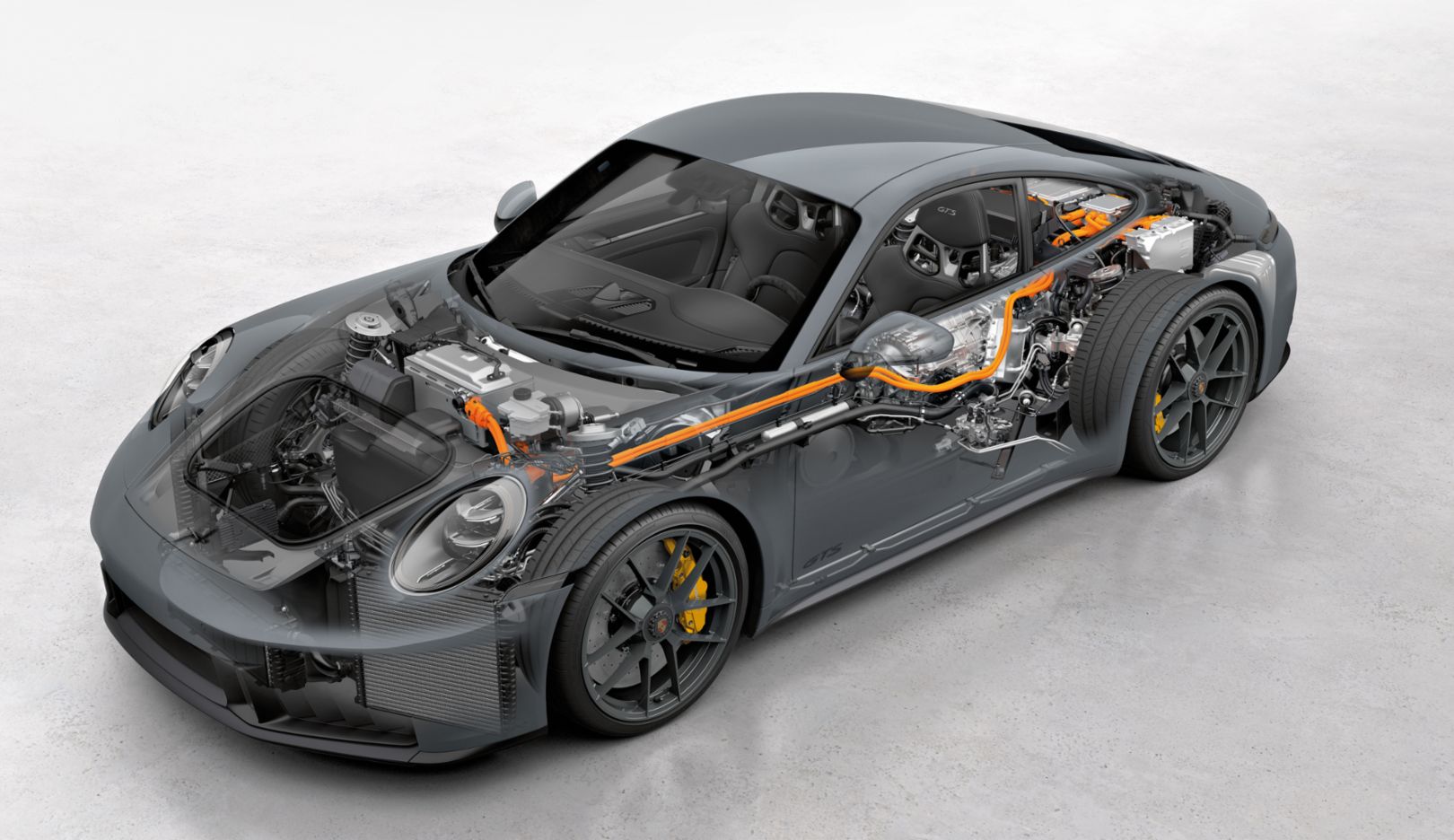
Hybridization:
The composite sketch illustrates the newly developed high-voltage components: 400-volt battery, electric motor in the dual-clutch transmission, electronic control units.At the heart of the technology is the electrically assisted turbocharger. There is an electric motor between the turbine powered by the exhaust gas and the compressor. Its function: to hit high speeds in a flash upon acceleration and build up boost pressure immediately without any delay. The turbocharger is given wings, as it were, by the small electric motor. “The technology enables responsiveness similar to that of a naturally aspirated engine,” explains Matthias Hofstetter, 911 Combustion and Hybrid System Project Manager. “And the acceleration figures are comparable with those of our all-electric sports cars.”
The acceleration at lower speeds is sensational, confirms Thomas Krickelberg. “We couldn’t have realized the intended performance increase with conventional technology while also complying with future emissions legislation.” Multiple measures led to the desired outcome. The displacement has increased again from 3.0 to 3.6 liters, while the combustion engine now only needs one rather than two turbochargers thanks to its electric assistance – coupled with improved responsiveness and greater dynamism.
“This saves weight and keeps the engine compact,” explains design engineer Reustle. As a result of the high-voltage system, the alternator and air-conditioning compressor could be powered by electricity, meaning that the fan drive was no longer needed. The 20 percent flatter crankcase creates space for the additional components, such as the pulse-controlled inverter feed and DC/DC converter. “We didn’t want to make the 911 any longer, wider, or heavier,” says Hofstetter, “we wanted to make optimum use of the existing package.” This means weight management coupled with a noticeable performance boost. The engine with electrically assisted turbocharger initially being offered in the GTS version delivers 398 kW (541 PS) and torque of 610 Nm. The powertrain also includes a permanently excited synchronous motor incorporated into the new, reinforced, eight-speed dual-clutch transmission (PDK). This assists the boxer engine right from idling speed with drive torque of up to 150 Nm and provides power of up to 40 kW.
All-electric locomotion as with a plug-in hybrid was not the objective with the 911 as a T-hybrid. “Because we also didn’t want the battery to be too big or too heavy,” says Hofstetter, explaining its capacity of 1.9 kWh.

Centerpiece:
The newly developed 3.6-liter boxer engine is a compact powerhouse – honoring the tradition of all 911 engines to date. The flat crankcase creates space for the T-hybrid engine’s components. The image shown above illustrates the inner workings of the electric exhaust gas turbocharger.Instead, it benefits from a system-based advantage of the electrically assisted turbocharger: exhaust energy recuperation. The electric motor in the exhaust gas turbocharger also works as a generator. It generates electric power of up to 11 kW (15 PS) that it extracts from the exhaust gas energy.
This is a principle which is both simple and fascinating. The electric motor works like a speed control. As soon as the boost pressure spikes due to higher revs per minute, the motor decelerates the turbine. This generates electricity, which is then fed into the battery or the electric engine. Thanks to this efficient energy recuperation, the relatively small battery is more than adequate for day-to-day usage, especially as the cell chemistry has been specifically designed with the T-hybrid needs in mind. “The technology allows the battery to deliver a lot of energy in a short space of time,” explains Hofstetter, “and be recharged relatively quickly.”
Another advantage of the electric turbocharger: the familiar waste gate is superfluous. This makes it a world first in this form. “The energy that once bypassed the turbine used to evaporate unused,” explains Hofstetter. “The pressure regulation now generates electrical energy.” That has a positive effect on the engine’s efficiency and therefore also on fuel consumption.
“Turbocharging in combination with hybridization, energy recuperation, in-engine friction reduction, cooling optimization, and optimum combustion chamber design is the perfect formula to comply with future exhaust gas and emissions legislation,” says engine developer Reustle in summary. “At the same time, we are satisfying ever-increasing expectations in terms of performance and efficiency.” The implementation of this formula is “an outstanding team effort on the part of everyone involved,” he says.
The six-cylinder boxer engine in the 911 remains a compact powerhouse – entirely in keeping with the tradition of the innovative engine that Hans Mezger once invented for the original 911.
Consumption data
911 Carrera GTS
911 GT3 RS
-
13.2 l/100 km
-
299 g/km
-
G Class
